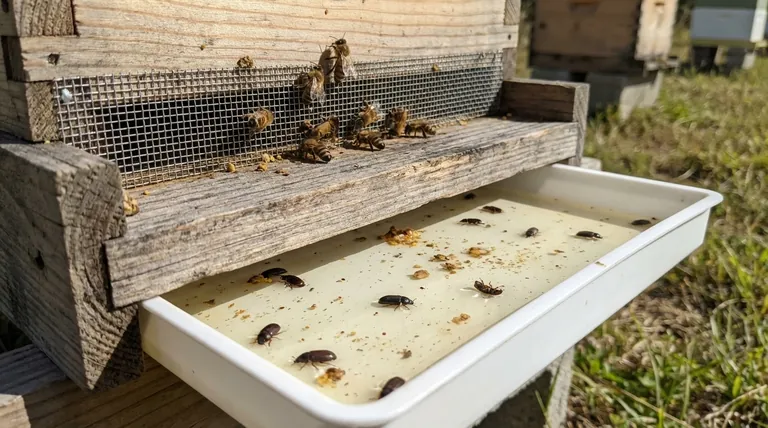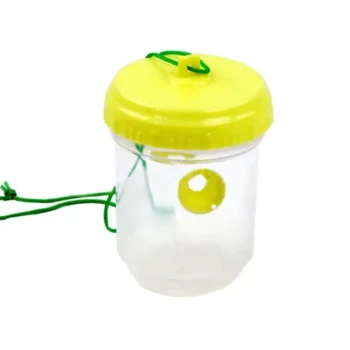In short, the small hive beetle tray is a trap. It is designed to slide underneath the Cypress Screened Bottom Board and be filled with oil or diatomaceous earth. The screened board allows beetles to fall through into the tray, where they are trapped and killed, while the tray's seal prevents bees from accessing the harmful substance.
The Cypress Screened Bottom Board and the Small Hive Beetle Tray work together as a two-part pest control system. The screen separates the bees from the trap, and the tray eliminates the beetles that fall through, protecting the colony without the use of in-hive chemicals.

How the System Works: A Two-Part Defense
To understand the purpose of the tray, it's essential to see how it functions in concert with the screened bottom board. Each component has a distinct and critical role in protecting the hive.
The Role of the Screened Bottom Board
The screened bottom board serves as the primary floor of the beehive. It is made of a wire mesh that is too small for bees to pass through.
However, the hive's bees will naturally chase and harass Small Hive Beetles (SHB). In their attempt to escape, the beetles often fall from the frames and through the screen, landing in the tray below.
The Role of the Beetle Tray
The tray is the actual trap in this system. It slides into a dedicated slot beneath the screen, creating a contained area for a killing agent.
This tray is typically filled with a shallow layer of mineral oil or diatomaceous earth (DE). When beetles fall through the screen, they land in this substance and are unable to escape.
The Importance of the Seal
A critical design feature is that the tray seals completely against the bottom board.
This seal is designed for one reason: to keep bees out. If bees could access the tray, they would also be killed by the oil or DE. The seal ensures this system is a targeted trap for pests, not a danger to the colony.
Understanding the Trade-offs
While highly effective, this system is not a "set and forget" solution. Proper management is key to its success and the health of your hive.
Regular Maintenance is Required
The tray must be periodically removed, cleaned, and refilled. Hive debris, dead beetles, and wax will accumulate over time. If left unattended, the oil can become rancid and the tray ineffective.
It's One Part of a Larger Strategy
This trapping system is a powerful tool for reducing SHB populations within a hive, but it may not eliminate them completely. It is best used as part of a larger Integrated Pest Management (IPM) approach that includes strong colony management.
Distinguishing from Ventilation Boards
It is important not to confuse the SHB tray with a standard insert or "mite board." While both slide under a screened bottom, a mite board is a solid, sticky board used for monitoring Varroa mite levels or for closing off ventilation during winter. The SHB tray is specifically designed to hold a liquid or powder and act as a trap.
Making the Right Choice for Your Goal
This system is a targeted solution for a specific problem. Consider your beekeeping goals to determine if it's the right fit for your apiary.
- If your primary focus is chemical-free beetle control: This integrated system is an excellent, non-chemical method for actively reducing SHB populations inside the hive.
- If you operate in a high-SHB pressure area: The constant trapping action of this system can significantly lower pest numbers and reduce stress on the colony.
- If you are looking for a completely hands-off solution: Be aware that the tray requires regular service to remain effective and sanitary.
By understanding how these components work together, you can effectively leverage this tool to protect your colony from this persistent pest.
Summary Table:
| Component | Primary Function | Key Feature |
|---|---|---|
| Screened Bottom Board | Allows beetles to fall through the mesh | Separates bees from the trap below |
| Small Hive Beetle Tray | Holds oil or diatomaceous earth to kill beetles | Seals completely to protect bees from the killing agent |
| The Combined System | Provides a two-part, non-chemical defense | Requires regular maintenance for optimal effectiveness |
Protect your commercial apiary with professional-grade equipment from HONESTBEE. Our Cypress Screened Bottom Boards and Small Hive Beetle Trays are designed for durability and effective, chemical-free pest management. Strengthen your Integrated Pest Management (IPM) strategy and keep your colonies healthy. Contact our wholesale team today to discuss your apiary's needs and place an order.
Visual Guide

Related Products
- Reusable Clear Small Hive Beetle Traps for Beehives Beetle Trapping Tools
- Reusable Aluminium Beetle Trap for Small Hive Beetles Silver Bullet
- Plastic Beetle Blaster Trap Beekeeping Tools and Supplies
- Black Plastic Beetle Barn Hive Beetle Trap for Beehives
- Removable Washable Hive Beetle Trap Attractants for Small Hive Beetles
People Also Ask
- What is the best time to use beetle traps? Master the Spring Strategy for Effective Hive Protection
- How should filled beetle traps be handled? Safely Remove and Dispose to Protect Your Hive
- How do hive beetle traps work? A Beekeeper's Guide to Non-Chemical Control
- Why are hive beetle traps important for beekeepers? Protect Your Hive from a Devastating Infestation
- How do Beetle Blasters trap adult beetles? A Simple, Non-Chemical Pest Control Solution



















